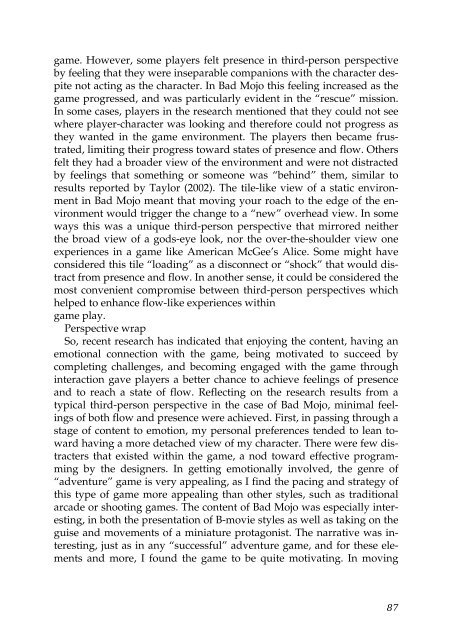Well Played 2.0: Video Games, Value and Meaning - OpenLibra
Well Played 2.0: Video Games, Value and Meaning - OpenLibra
Well Played 2.0: Video Games, Value and Meaning - OpenLibra
You also want an ePaper? Increase the reach of your titles
YUMPU automatically turns print PDFs into web optimized ePapers that Google loves.
game. However, some players felt presence in third-person perspective<br />
by feeling that they were inseparable companions with the character despite<br />
not acting as the character. In Bad Mojo this feeling increased as the<br />
game progressed, <strong>and</strong> was particularly evident in the “rescue” mission.<br />
In some cases, players in the research mentioned that they could not see<br />
where player-character was looking <strong>and</strong> therefore could not progress as<br />
they wanted in the game environment. The players then became frustrated,<br />
limiting their progress toward states of presence <strong>and</strong> flow. Others<br />
felt they had a broader view of the environment <strong>and</strong> were not distracted<br />
by feelings that something or someone was “behind” them, similar to<br />
results reported by Taylor (2002). The tile-like view of a static environment<br />
in Bad Mojo meant that moving your roach to the edge of the environment<br />
would trigger the change to a “new” overhead view. In some<br />
ways this was a unique third-person perspective that mirrored neither<br />
the broad view of a gods-eye look, nor the over-the-shoulder view one<br />
experiences in a game like American McGee’s Alice. Some might have<br />
considered this tile “loading” as a disconnect or “shock” that would distract<br />
from presence <strong>and</strong> flow. In another sense, it could be considered the<br />
most convenient compromise between third-person perspectives which<br />
helped to enhance flow-like experiences within<br />
game play.<br />
Perspective wrap<br />
So, recent research has indicated that enjoying the content, having an<br />
emotional connection with the game, being motivated to succeed by<br />
completing challenges, <strong>and</strong> becoming engaged with the game through<br />
interaction gave players a better chance to achieve feelings of presence<br />
<strong>and</strong> to reach a state of flow. Reflecting on the research results from a<br />
typical third-person perspective in the case of Bad Mojo, minimal feelings<br />
of both flow <strong>and</strong> presence were achieved. First, in passing through a<br />
stage of content to emotion, my personal preferences tended to lean toward<br />
having a more detached view of my character. There were few distracters<br />
that existed within the game, a nod toward effective programming<br />
by the designers. In getting emotionally involved, the genre of<br />
“adventure” game is very appealing, as I find the pacing <strong>and</strong> strategy of<br />
this type of game more appealing than other styles, such as traditional<br />
arcade or shooting games. The content of Bad Mojo was especially interesting,<br />
in both the presentation of B-movie styles as well as taking on the<br />
guise <strong>and</strong> movements of a miniature protagonist. The narrative was interesting,<br />
just as in any “successful” adventure game, <strong>and</strong> for these elements<br />
<strong>and</strong> more, I found the game to be quite motivating. In moving<br />
87

















